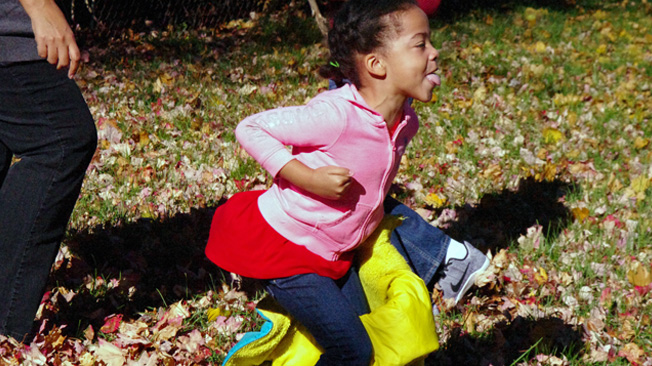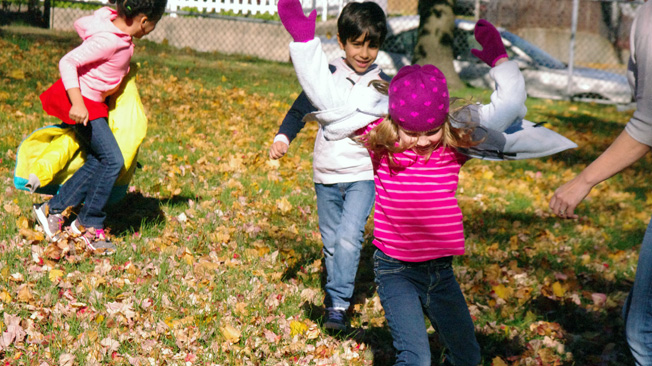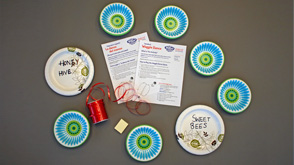Waggle Dance
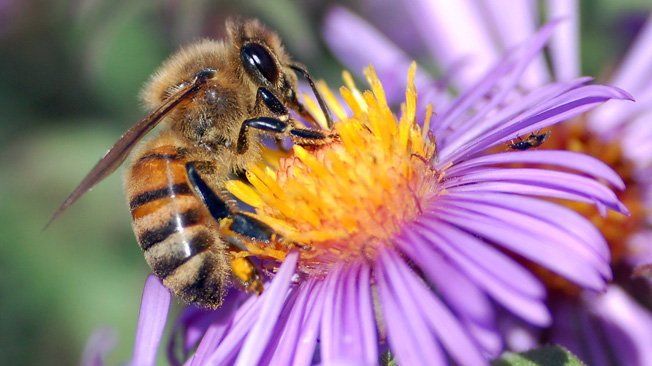
What Is This Activity?
How do busy bees “tell” each other where to find pollen? In this game, families play bees that find pollen by doing a dance.
Introduction
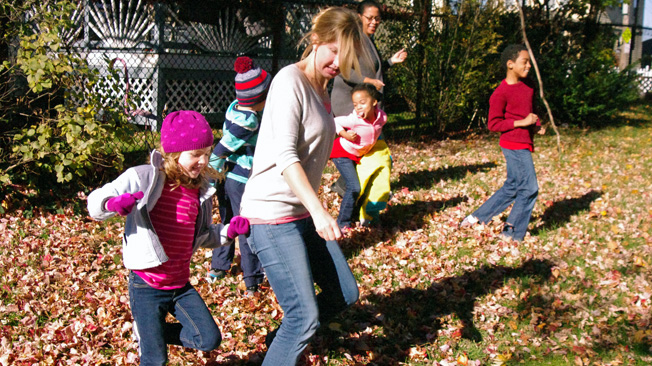
Learning Goals
Big Science Idea:
- Bees and flowers depend on each other to survive and thrive.
Skills kids will use to investigate it:
Model how bees communicate to find and collect pollen from flowers
Communicate strategies flowers use to attract bees for pollination
Communicate how bees and flowers depend on each other for survival
How Do You Get Ready?
Read the activity and gather the materials.
Stick the 24 sticky notes inside the six bowls in uneven numbers—e.g., four in one bowl, seven in another, etc.
Scout out an outdoor area that has trees, flowers, benches, and other places to hide objects, like a local park or your program’s backyard.
Troubleshoot any safety concerns (traffic, poison ivy, sharp objects, etc.).
Place the six bowls all around the outer edges of the play area and the two plates in the center.
Copy or print the “Waggle Dance” handout (one per family).
If you don’t plan to show the “The Brick-Eating Ivy Mystery” video that is paired with this activity on the website, watch it ahead of time and jot down concepts to share with families during the activity.
Warm-up 10–15 minutes
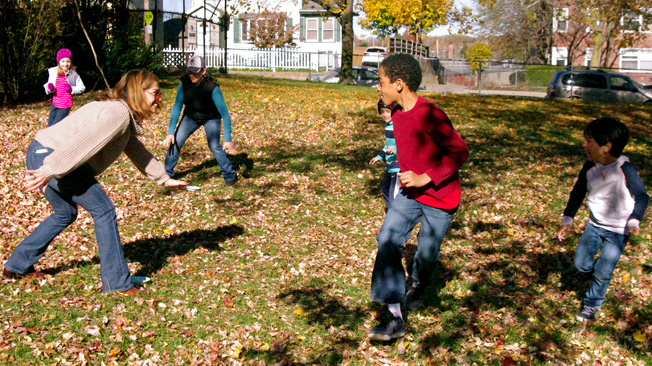
(Science Skills: Model how bees collect pollen from flowers)
Bee Race. In this team race game, the six bowls are flowers full of “Pollen” (the yellow sticky notes). The two plates are “Flowers” that need Pollen to make seeds.
Ask a kid volunteer to play a “Bee-Eater Bird” and give him or her a colored ribbon.
Divide the families into two hives of “Bees”: the Honey Hive and the Sweet Bees.
All Bees start in the center. The Bee-Eater Bird can “fly” anywhere except the center.
On your signal, the Bees start collecting one piece of Pollen at a time from any bowl and sticking it to their team’s plate. (Ask an adult/parent to monitor this step. Invite other adults to play; their kids will love it!)
The Bird tries to tag Bees with the ribbon. Tagged Bees become Bee-Eater Birds. They take a ribbon from you and begin tagging Bees.
The race ends when the Pollen supply is gone, the last Bee turns into a Bird, or time is up. The team with the most Pollen is the winner.
Ask: What helped you collect more pollen? (Spread out to avoid the Bird, run fast, scout out rich pollen sources and tell your teammates, etc.) Why do Bees collect pollen? Why do flowers make pollen? Revisit these questions after the activity.
Activity 25–35 minutes
Waggle Dance
(25–35 minutes)
(Science Skills: Model how bees communicate to find and collect pollen; communicate strategies flowers use to attract bees for pollination)
Give the families a few minutes to look around at flowers, if they’re in season. What colors are the petals? Which blooms are scented? Is there pollen (a white, yellow, or brown powder, usually in the center)? Any bees? If you were a flower, how would you get bees to visit you?
Explain that pollen is food for bees. (Pollen is protein for bees, which do not eat meat; flower nectar is a sugary snack for short-term energy.) Bees find pollen by zeroing in on the color or scent of a flower. They collect what they can and then tell the bees back at the hive where to find it.
Wonder aloud: Bees can’t talk, so how do they “tell” the other bees where the pollen is?
Pass out the ribbons (one per family, the same ones from the Warm-Up) and the “Waggle Dance” handout.
Review the activity and demonstrate the steps of the Waggle Dance. Have the families copy your moves. Explain that the dance is a simplified version of how real bees communicate.
Have each family follow the directions on the handout to play a Waggle Dance game. (You can also have two or more families waggle dance together.)
Circulate to support and encourage them.
Wrap-up 8–10 minutes
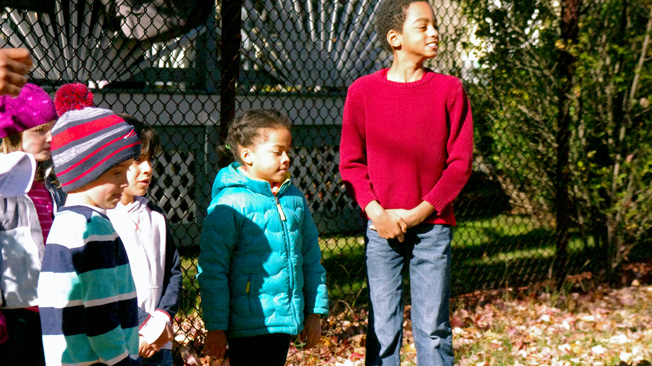
(Science Skills: Science Skills: Communicate how bees and flowers depend on each other for survival; communicate strategies flowers use to attract bees for pollination)
Wonder aloud again: Why do bees collect pollen? Why do flowers make food for bees? What’s in it for them? If needed, explain that some of the flower’s pollen sticks to the bee and gets carried to another flower. Then what? (That flower uses pollen to make seeds, which can grow new flowers.)
Ask: How do bees and flowers depend on each other to survive? (Bees would starve without pollen and nectar from flowers; flowers would die out without bees to help them make seeds.)
Role-play: Ask everyone to stand perfectly still, like a flower. No one can move! No one can make a sound! Ask: How could you get people passing by to notice you? If kids aren’t sure, remind them to think about how flowers attract bees. (Some ideas: Wear something bright and colorful, smell really good, offer up free food, etc.)
Encourage families to take home the “Waggle Dance” handout to repeat the activity in their neighborhoods. Point out the “Explore Some More” activities as well. If you like, give them “Explore Animals Around You” handout to provide them with more ideas on how to continue investigating animals together.
Explore Some More
Fancy Dancer
Bee communication has a lot more steps to the waggle dance. For example, when bees circle round and round, that means flowers are very close to the hive. Search for “bee dance” videos online, including one on PBS’s NOVA site, to see the dancing in action. Besides the direction and distance of flowers, what if bees could communicate other information? Encourage families make up their own bee dance steps to tell their “hive mates”:
Amount of pollen and nectar
Color of the flowers (bees can’t see red)
Presence of predators (bee-eater birds, for example)
“Spread the word!” to other bees

